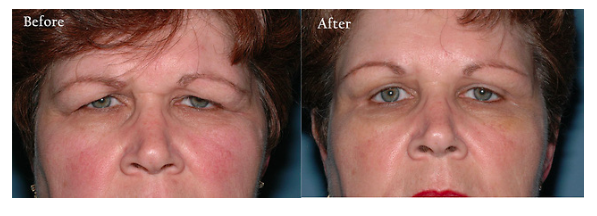Eyelid surgery
Every year, one hundred thousand men and women choose blepharoplasty to improve their appearance. Droopy eyelids can make you look older and can also impair vision. Blepharoplasty corrects these problems and also removes the puffiness and bags under the eyes that make you look worn and tired. This procedure cannot change dark circles, fine lines and wrinkles around the eyes, nor can it change loose eyebrows. Although blepharoplasty is often performed as a single procedure, your surgeon may also recommend a lift, facelift, or skin resurfacing to achieve the best results.
If you are wondering how blepharoplasty can change your appearance, you need to know how blepharoplasty is done and what you can expect from this procedure. On this page, you’ll find answers to many common questions and information to get you started considering blepharoplasty. Successful facial plastic surgery is the result of a good relationship between patient and surgeon. Trust, based on realistic expectations and demanding medical experience, is developed in the preoperative counseling stages. Your surgeon can answer specific questions about your specific needs.
Is blepharoplasty for you?
As with all facial plastic surgery, good health and realistic expectations are prerequisites. Blepharoplasty removes excess fat, muscle and skin from both the upper and lower eyelids. The results can be a refreshed look, with a younger, firmer eye area.
People with circulatory, eye or serious medical conditions must rely on the diagnostic skills of their personal specialists to determine if blepharoplasty is an option to consider. Consultation with your facial plastic surgeon can help you decide whether any additional, complementary surgery would increase the success of the procedure. Your surgeon may recommend scheduling a simultaneous browlift to correct a droopy brow and smooth the forehead or skin resurfacing to remove fine lines around the eyes.
Deciding on blepharoplasty
Whether surgery is desired for functional or cosmetic reasons, choosing a qualified facial plastic surgeon is of utmost importance. The patient must also commit to following the surgeon’s preoperative and postoperative instructions.
During the preoperative consultation, you will be examined or asked to answer questions about your vision, tear production, lens wear, and your wishes for surgery. Your surgeon will explain what to expect from blepharoplasty and take a complete medical history. Factors to be weighed include age, skin type, ethnic background and degree of visual impairment. In addition, you can expect an open and honest exchange between you and your surgeon, which will set the stage for a successful outcome.
After a mutual decision is made by both you and your surgeon, the technique indicated for your individual procedure will be discussed. The type of anesthesia, the surgical setup, any supportive surgery, and the risks and costs involved in the procedure will be described.
Understanding surgery
In upper eyelid surgery, the surgeon first marks the individual lines and folds of the eyelids to keep the scars as invisible as possible along these natural folds. An incision is made and excess fat, muscle and loose skin is removed. Fine sutures are used to close the incisions, thus minimizing the visibility of any scarring.
In lower eyelid surgery, the surgeon makes the incision in an inconspicuous spot along the lash line and smiling folds of the lower eyelid. Excess fat, muscle and skin are then removed before the incision is closed with fine stitches. Eyelid swelling caused mainly by excess fat can be corrected with transconjunctival blepharoplasty. The incision in this case is made inside the lower eyelid and the excess fat is removed. When sutures are used to close this type of incision, they are invisible to the eye. They also self-dissolve and leave no visible marks. Under normal circumstances, blepharoplasty can take from one to two hours.
What to expect after surgery
Immediately after the surgery is complete, your surgeon may apply tiny sterile dressings. This is not done for transconjunctival blepharoplasty. It is not critical to cover the eyes. However, an ointment can be used to prevent dryness of the eye area. Some degree of swelling and bruising is normal. Cold compresses, as well as elevating the head when lying down, will promote healing and relieve discomfort. Your surgeon will prescribe medication for the discomfort.
For a week and a half after blepharoplasty, you will clean the eye area (eyes may feel sticky, dry and itchy). Eye drops may be recommended. Your surgeon will also list activities and environments to avoid in the weeks immediately following surgery. Permanent stitches will be removed three to five days after surgery. Self-absorbable stitches will dissolve on their own.
Facial plastic surgery makes it possible to correct many facial defects and signs of premature aging that can undermine self-confidence. By changing the way you look, facial plastic surgery can help you change how you feel about yourself.
Insurance generally does not cover surgical procedures performed purely for cosmetic reasons. Surgery to correct or improve vision or surgery to disfigure or injure the eyes can be fully or partially reimbursed. It is the patient’s responsibility to contact the insurance carrier for information regarding the degree of coverage.
© Copyright 2017 American Academy of Facial and Reconstructive Plastic Surgery


